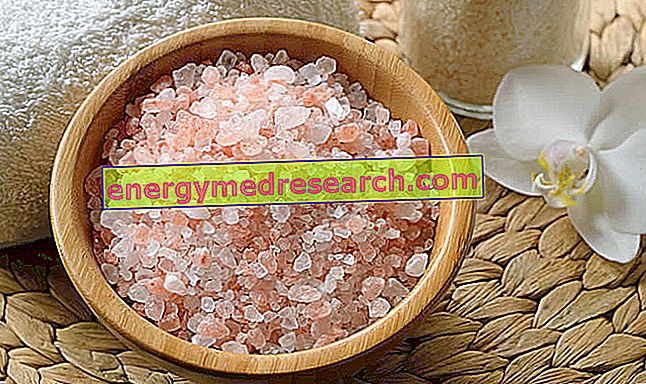What is it about?
The pink salt of the Himalayas is a rock salt (or halite) extracted from the Khewra mine, located in the district of Jhelum, within the Pakistani region of Punjab (which emerges from the Indo Gangetica plain).
The promontories from which this mineral made of sodium chloride is extracted are located 300km from the Himalayan mountain range, 298km from Amritsar (India) and 260km from Lahore.

Himalayan pink salt is sometimes reddish or pink, with some translucent white crystals.
Despite being extracted from underground mines, the pink salt of the Himalayas is a real sea salt dating back to the primordial era, when most of the earth's surface was still submerged by water.
Composition
In 2003, the Bavarian State Office for Health and Food Safety (Bayerisches Landesamt für Gesundheit und Lebensmittelsicherheit) analyzed 15 samples of Himalayan pink salt sold in Germany, detecting (in addition to sodium chloride) at least ten different minerals . In total, there are 84 elements of the pink Himalayan salt.
The chemical distribution of Himalayan pink salt includes: 95-96% sodium chloride (average value, however not more than 98% or less than 85%), 2-3% of polyalite - K 2 Ca 2 Mg ( SO 4 ) 4 · 2 (H 2 O) - and small amounts of many other minerals. The pink or reddish color is due to iron oxide.
Below, we will mention the 11 minerals prevalent in the pink salt of the Himalayas.
| Element | Ion | Atomic number | Concentration | Method / Source |
| Hydrogen | H | 1 | 0, 30g / kg | DIN |
| Lithium | There | 3 | 0, 40g / kg | AAS |
| Oxygen | OR | 8 | 1, 20g / kg | DIN |
| Sodium | Na | 11 | 382.61g / kg | FSM |
| Magnesium | mg | 12 | 0.16g / kg | AAS |
| Sulfur | S | 16 | 12.4 g / kg | TXRF |
| Chlorine | Cl | 17 | 590, 93g / kg | gravimetric |
| Potassium | K | 19 | 3.5g / kg | FSM |
| Football | Ca | 20 | 4.05g / kg | Titration |
| Strontium | Sr | 38 | 0.014g / kg | AAS |
| Iodine | THE | 53 | <0.1 g / kg | potentiometric |
Health Benefits
Himalayan pink salt is considered a natural source of several minerals, but absent (or almost) in white salt; these elements, as happens with other food ingredients, are more abundant in "integral" salts not subjected to refining (just think of the analogies with cereals, legumes, vegetables, fruits, etc.).
It is assumed that, in a similar way to physiological systems, also in the pink salt of the Himalayas minerals act interacting with each other and can thus produce an effect higher or different from the sum of their individual effects (synergistic effect).
Himalayan pink salt is also rich in iodine; therefore it does not need to be artificially enriched.
Himalayan pink salt is totally free of anti-caking agents (E535 and E536 - Sodium and Potassium Ferrocyanide). These, if taken in high doses (necessarily> 25mg / kg of body weight) are considered toxic to the organism; however, at concentrations usually used in the common salt, they should not give any kind of problem.
Himalayan pink salt is also attributed with lower total sodium consumption; this mineral, being organized in larger and more bulky crystals than the traditional salt, occupies more space and, for the same volume, is therefore contained in lower quantity (mass).
The composition of the more than 80 minerals of the Himalayan salt could be responsible for:
- Better electrolyte balance
- Increased hydration
- Better regulation of water content both inside and outside the cells
- Better pH balance and contribution to the prevention of muscle cramps
- Help in the proper functioning of the metabolism
- Bone reinforcement
- Reduced blood pressure
- Aid in intestinal nutritional absorption
- Reduction of the incidence of goiter (impairment of the thyroid gland)
- Improved circulation
- Dissolution and elimination of sediments with elimination of toxins.
Obviously, the extent of all these effects is not well defined and depends above all on the physical condition of the person taking it. In fact, if these potential benefits can have a certain response in the case of nutritional deficiencies of the minerals in question, it is very unlikely that they are also applicable to the norm-nourished population.
Some believe that pink Himalayan salt can also improve libido, reduce the signs of aging and detoxify the body from heavy metals; on the other hand, there are neither bases nor scientific evidence to support these hypotheses.
Given the absence of scientific studies to support, the attention of the press to the potential benefits of Himalayan pink salt evidently betrays a certain pressure of economic interests aimed at encouraging their consumption.
uses
Himalayan salt is commonly used as a discretionary salt; it is used instead of other types of table salt, for preserving in brine, for direct salting of meat and fish (conservative dehydration) and in bath products (bath salts).
Real blocks of salt are used as cooking surfaces (up to 200 ° C) or as dishes in the service of food.
By working small blocks of Himalayan salt, inside which an incandescent light bulb (or a candle) is placed, it is possible to obtain ornamental lamps.
Some argue that these objects can positively change the atmospheric composition of ions; however, there is no scientific evidence to prove its effectiveness.



